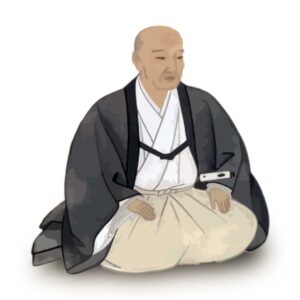
A tea master in the early days of the tea ceremony.
Master of Rikyu.
Born in 1502.
His family name is Takeno and his first name is Nakamura.
His child name was Shokikumaru and his nickname was Shingoro.
He went by the names Daikokuan and Ikkan.
A descendant of the Takeda clan of Wakasa Province (Fukui Prefecture).
Under the patronage of the Miyoshi clan, he became wealthy by dealing in leather and manufacturing armory.
Nakamura was an early student of the arts, and in 1525, at the age of 24, he went to Kyoto to study the art of poetry under Sanjonishi Sanetaka.
In 1532, at the age of 31, his mother died, and he shaved his hair and assumed the name of Shaoou.
In 1549, at the age of forty-eight, he was given the title of “Ippan” by Obayashi Sotanto of Nanshuji Temple in Sakai.
During this period, he traveled back and forth between Kyoto and Sakai, and is said to have built a daikokuan (hermitage) by the Shijo barbershop in Kyoto.
He studied tea under Sori Fujita, Sogo Jyushiya, and Souchen in Shimogyo, and deepened the direction of Wabicha by combining the tea tradition of Shuko with the sensibilities of a wealthy Sakai merchant and his own education in Japanese studies, eventually leading to his disciple Sen no Rikyu, the great master of chanoyu.
In the “Yamakami Souji Ki,” it is written, “Up to the time of my death, I had the style of Hachijukou, but after that, Shao’ou completely changed his style and added new styles.
He also taught that we should respect the original idea of Fujiwara no Teika’s “Preface to the Outline of Poetry” given to him by Sanetaka, and that we should make Teika’s “Look over and you will see neither flowers nor autumn leaves, the autumn evening twilight at Uranotomaya” our philosophy of tea, and that “The old masters say that after one becomes a tea ceremony master, one should be wretched with a single kind of tool, and that one should be devoted to the art of tea ceremony. The tea ceremony is also said to be accomplished in the same way, as Shao’ou always said by Tsuji Genya” (Souji Yamakami, “Souji Yamakami”), and he himself said, “Be honest, modest, deep, and unashamed” (Shao’ou “Wabi no Bun”). The famous Shaowu Fukurodana, which is described in a letter to Nomura Sokaku by Rikyu, also says, “Fukurodana should not be painted or lacquered or maki-e, but should be a board as it is, with the appearance of a farmer’s house.
Based on these ideas, Shaowo changed the four-and-a-half-tatami-mat style of the tea room to the grass style, which had existed since Shuko’s time, and also proposed Wabi-utensils such as the orietaiko, kurodana, dofu furnace, silkworm tea caddy, wooden crockery, bamboo lid rest, and bamboo jizai, and also explored new values in Wabi-ware in pottery, including Nanban potato head water jar, Shigaraki oniokake water jar, and Bizen menokake kensui.
However, Shaowu also possessed many old Chinese masterpieces, and his collection of new and old items is said to have numbered as many as 60 kinds, according to his discernment: “All of the 10,000,000 tools of the day were called out to him by Shaowu’s eyes” (Souji Yamakami).
Most of the wealthy tea masters in Sakai at the time, including Miyoshi Saneyoshi and other great masters, were Shao’o’s disciples.
The most famous of these were Tsuda Munenori, Imai Munehisa, and Sen no Rikyu. Takeno Munekara was his heir apparent.
He died on October 29, 1555, at the age of fifty-four.



